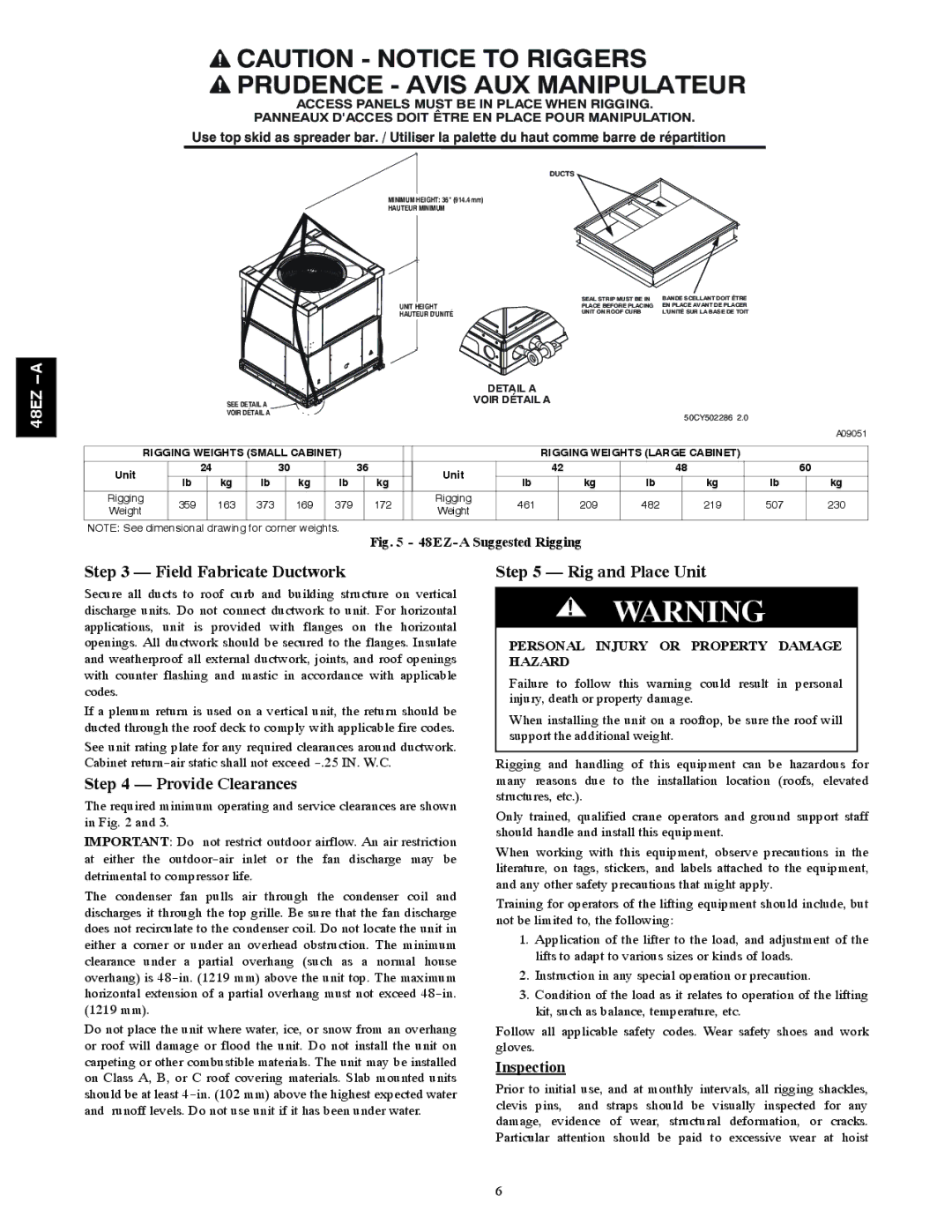
![]() CAUTION - NOTICE TO RIGGERS
CAUTION - NOTICE TO RIGGERS ![]() PRUDENCE - AVIS AUX MANIPULATEUR
PRUDENCE - AVIS AUX MANIPULATEUR
ACCESS PANELS MUST BE IN PLACE WHEN RIGGING.
PANNEAUX D'ACCES DOIT ÊTRE EN PLACE POUR MANIPULATION.
Use top skid as spreader bar. / Utiliser la palette du haut comme barre de répartition
DUCTS
MINIMUM HEIGHT: 36" (914.4 mm)
HAUTEUR MINIMUM
48EZ -- A
|
|
|
| BANDE SCELLANT DOIT ÊTRE |
|
|
|
| |
|
| SEAL STRIP MUST BE IN | ||
UNIT HEIGHT | PLACE BEFORE PLACING | EN PLACE AVANT DE PLACER | ||
HAUTEUR D'UNITÉ | UNIT ON ROOF CURB | L'UNITÉ SUR LA BASE DE TOIT | ||
|
|
|
|
|
|
|
|
|
|
|
|
|
|
|
|
|
|
|
|
|
|
|
|
|
|
|
|
|
|
|
|
|
|
|
|
|
| DETAIL A |
|
|
|
|
|
|
|
|
| |
|
|
|
| SEE DETAIL A |
|
|
|
|
|
|
| VOIR DÉTAIL A |
|
|
|
|
|
|
| ||||
|
|
|
|
|
|
|
|
|
|
|
|
|
|
|
|
|
|
|
|
|
| ||
|
|
|
| VOIR DÉTAIL A |
|
|
|
|
|
|
|
|
|
|
|
|
| 50CY502286 2.0 |
|
|
| ||
|
|
|
|
|
|
|
|
|
|
|
|
|
|
|
|
|
|
|
|
|
| ||
|
|
|
|
|
|
|
|
|
|
|
|
|
|
|
|
|
|
|
|
|
|
| A09051 |
|
|
|
|
|
|
|
|
|
|
|
|
|
|
|
|
|
|
|
|
| |||
| RIGGING WEIGHTS (SMALL CABINET) |
|
|
|
|
|
| RIGGING WEIGHTS (LARGE CABINET) |
|
|
| ||||||||||||
Unit |
| 24 |
|
| 30 |
| 36 |
| Unit |
|
| 42 |
| 48 |
|
| 60 | ||||||
| lb |
| kg | lb |
| kg | lb |
| kg |
|
| lb |
| kg | lb |
| kg |
| lb |
| kg | ||
|
|
|
|
|
|
|
|
|
|
|
| ||||||||||||
Rigging | 359 |
| 163 | 373 |
| 169 | 379 |
| 172 |
| Rigging |
| 461 |
| 209 | 482 |
| 219 |
| 507 |
| 230 | |
Weight |
|
|
|
|
| Weight |
|
|
|
|
| ||||||||||||
|
|
|
|
|
|
|
|
|
|
|
|
|
|
|
|
|
|
|
|
|
| ||
|
|
|
|
|
|
|
|
|
|
|
|
|
|
|
|
|
|
|
|
|
|
|
|
NOTE: See dimensional drawing for corner weights.
Fig. 5 - 48EZ-A Suggested Rigging
Step 3 — Field Fabricate Ductwork
Secure all ducts to roof curb and building structure on vertical discharge units. Do not connect ductwork to unit. For horizontal applications, unit is provided with flanges on the horizontal openings. All ductwork should be secured to the flanges. Insulate and weatherproof all external ductwork, joints, and roof openings with counter flashing and mastic in accordance with applicable codes.
If a plenum return is used on a vertical unit, the return should be ducted through the roof deck to comply with applicable fire codes.
See unit rating plate for any required clearances around ductwork. Cabinet
Step 4 — Provide Clearances
The required minimum operating and service clearances are shown in Fig. 2 and 3.
IMPORTANT: Do not restrict outdoor airflow. An air restriction at either the
The condenser fan pulls air through the condenser coil and discharges it through the top grille. Be sure that the fan discharge does not recirculate to the condenser coil. Do not locate the unit in either a corner or under an overhead obstruction. The minimum clearance under a partial overhang (such as a normal house overhang) is
Do not place the unit where water, ice, or snow from an overhang or roof will damage or flood the unit. Do not install the unit on carpeting or other combustible materials. The unit may be installed on Class A, B, or C roof covering materials. Slab mounted units should be at least
Step 5 — Rig and Place Unit
!WARNING
PERSONAL INJURY OR PROPERTY DAMAGE HAZARD
Failure to follow this warning could result in personal injury, death or property damage.
When installing the unit on a rooftop, be sure the roof will support the additional weight.
Rigging and handling of this equipment can be hazardous for many reasons due to the installation location (roofs, elevated structures, etc.).
Only trained, qualified crane operators and ground support staff should handle and install this equipment.
When working with this equipment, observe precautions in the literature, on tags, stickers, and labels attached to the equipment, and any other safety precautions that might apply.
Training for operators of the lifting equipment should include, but not be limited to, the following:
1.Application of the lifter to the load, and adjustment of the lifts to adapt to various sizes or kinds of loads.
2.Instruction in any special operation or precaution.
3.Condition of the load as it relates to operation of the lifting kit, such as balance, temperature, etc.
Follow all applicable safety codes. Wear safety shoes and work gloves.
Inspection
Prior to initial use, and at monthly intervals, all rigging shackles, clevis pins, and straps should be visually inspected for any damage, evidence of wear, structural deformation, or cracks. Particular attention should be paid to excessive wear at hoist
6
